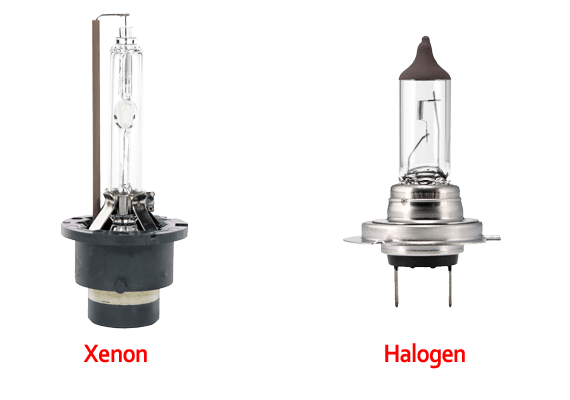Every time you turn around, there’s another car with xenon headlights. But what are they? And why are they considered better than the standard halogen headlights?
Keep reading to be enlightened about what halogen and xenon lights are and how they work. Plus, which type is best for your car?
What are halogen headlights?
Halogen headlights can be found on approximately 80% of the cars on the road today, making them the most common type of headlights currently available. They offer many advantages: they’re cheap to manufacture, easy to replace, give a bright, yellow-white light and last up to 1,000 hours.
How do they work?
A halogen headlight consists of a thin tungsten filament surrounded by a halogen gas in a glass filament capsule which is extremely resistant to high temperatures. It works by sending electricity through the tungsten filament inside the glass capsule. The electrical current heats up the tungsten to approximately 2,500° Celsius and it starts to glow (incandescent process). The bulb uses an inert gas and a small amount of a halogen such as iodine or bromine.
What are xenon (HID) headlights?
Xenon headlights are more popular on high-end cars of the last decade, where they have a premium, stylish look. Also known as High-Intensity Discharge (HID) lamps, xenon headlights deliver a white-blue light, approximately two to three times brighter than a halogen, last approximately 2,500 hours and are energy efficient.
How do they work?
A xenon (HID) lightbulb is a transparent quartz housing with tungsten electrodes at each end and filled with a mixture of gases. The lights work in three steps:
1. Ignition. A high voltage pulse produces a spark that ionizes the xenon gas and creates a connection of current between the electrodes.
2. Heats up. The temperature quickly rises, ionizing the gas mixture, lowering the resistance between the two electrodes.
3. Bright light. The ballast switches to continuous operation with a constant supply of power so the light won’t fail. The ballast is a capacitor that creates and regulates the high-voltage that xenon lights need to operate.
The xenon gas is only used during the start up to give instant light while the other gases are still heating up to their operating temperature. Even so, it can take a few seconds for the light to turn fully on.
Xenon vs. halogen headlights
Now that we’ve covered the basics, it’s time to ask: which type of headlight is the best? And why?
- Energy efficiency
Compared to xenon headlights, halogen lights require less energy to start up, but more energy to keep going. They also generate large amounts of heat, which is wasted energy. As xenon lighting uses gas as its energy source, it needs less electricity to generate the light. But, even though xenon headlights are slightly more energy efficient, the amounts are fairly small that you probably won’t notice a major difference. - Lifespan
Xenon headlights last a lot longer than halogen ones – 2,000 to 2,500 hours for xenon headlights compared to 400 to 1,000 for halogen. - Cost
In general halogen lights are cheaper than xenon headlights to produce, purchase, install and repair. - Colour
The colour generated also differs. Xenon headlights have a colour temperature of 4000K-6000K, which is a bright white-blue light similar to natural daylight and halogen headlights have a colour temperature of 3200-5000K, which is a warmer, yellow-white light. - Illumination
Xenon headlights are over twice as bright as halogen ones, offering approximately 3,000 lumens and about 90 Mcd/m2 compared to 1,400 lumens and about 30 Mcd/ m2 for halogen lights. The difference in lumens explains why halogen lights don’t illuminate the road as fully as xenon lights. However, xenon headlights are less effective in foggy weather conditions compared to halogen lights.
- Installation
Installing halogen headlights is straightforward as they simply click into position. Xenon headlights require a ballast, which makes installation a little more complicated. You need mandatory light washer when installing xenon bulbs, as dirt on the light module might be dangerous for drivers coming from the opposite side.
- Construction
While both types of headlights are fairly robust, it is important to be careful when handling halogen lights. Touching a halogen light with your bare hands could put grease on the bulb, weakening it and resulting in it breaking. Additionally, as halogen headlights contain high pressure gas, it is a good idea to have some kind of shield in case they shelter. Some versions of xenon headlights contain toxic substances, such as metal mercury, which has a negative impact on our health if they break. - Safety vs. glare
Studies demonstrate that drivers react faster and more accurately to the situation on the road when they have good xenon headlights compared to halogen ones. This means that xenon headlights help with road safety. However, as xenon headlights are brighter, they can potentially dazzle other drivers. For that reason, it’s important to use your automatic beam levelling control and light module washer installations.
- Start-up times
Halogen headlights are at full brightness as soon as you turn the headlights on. Xenon headlights, on the other hand, require a few seconds to warm up to be able to reach full brightness. During this start-up period, the headlight uses the xenon gas to produce light. As soon as the filament is at operating temperature the other gases are used.
The content contained in this article is for entertainment and informational purposes only and should not be used in lieu of seeking professional advice from a certified technician or mechanic. We encourage you to consult with a certified technician or mechanic if you have specific questions or concerns relating to any of the topics covered herein. Under no circumstances will we be liable for any loss or damage caused by your reliance on any content.
